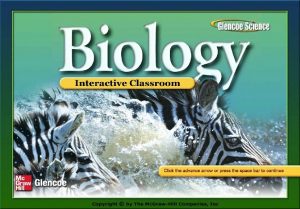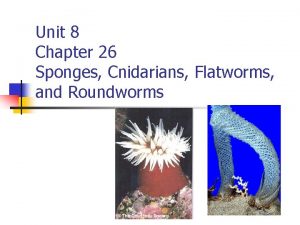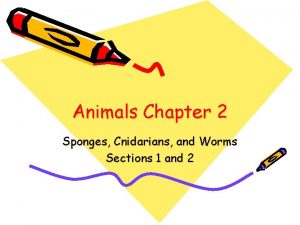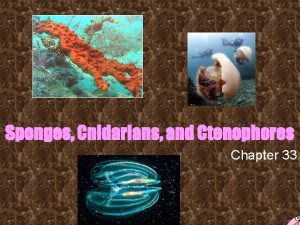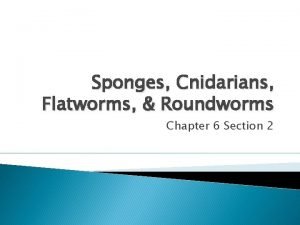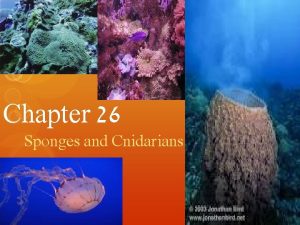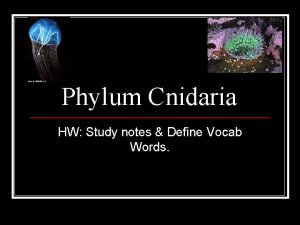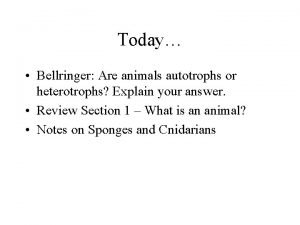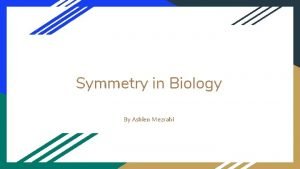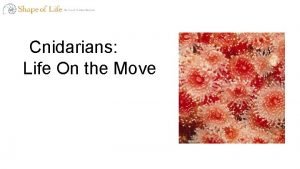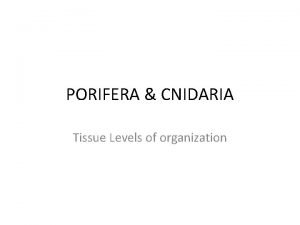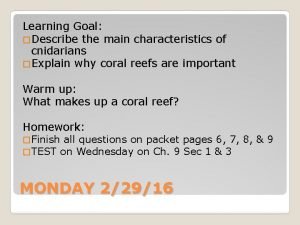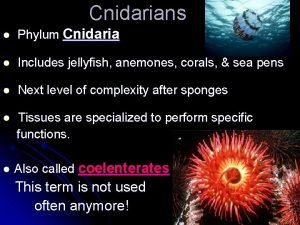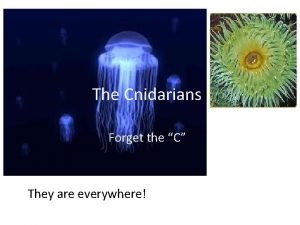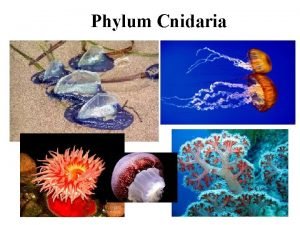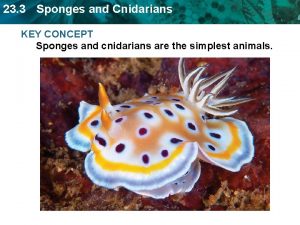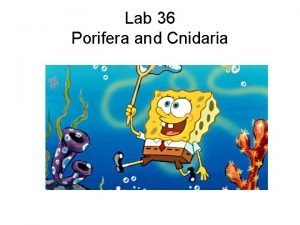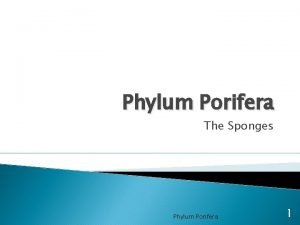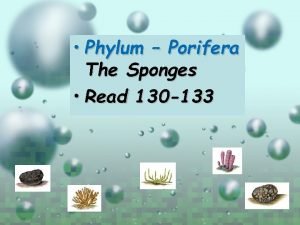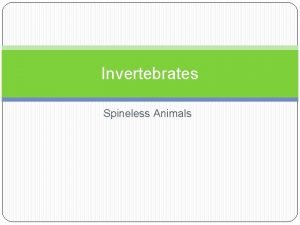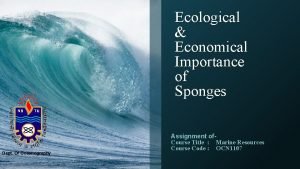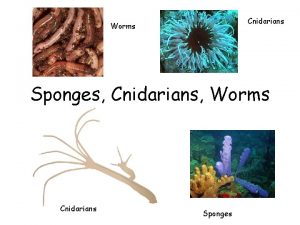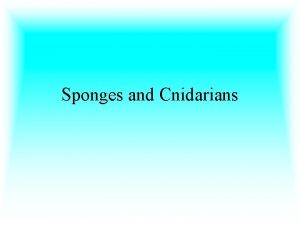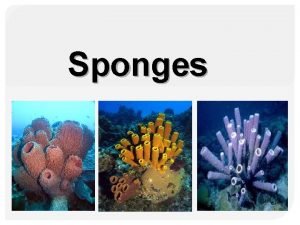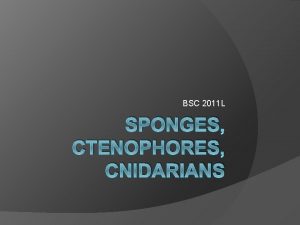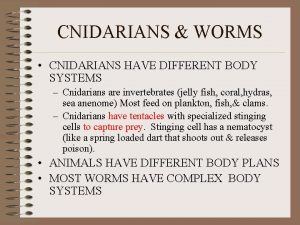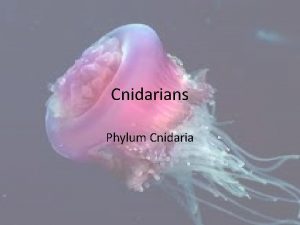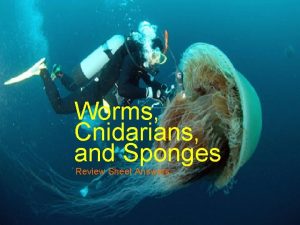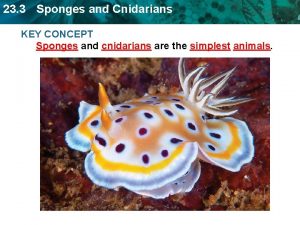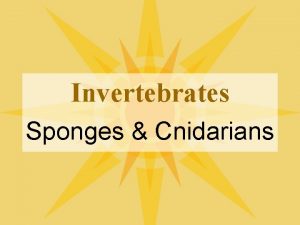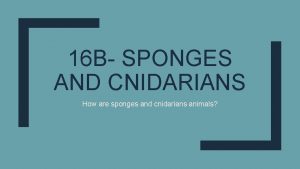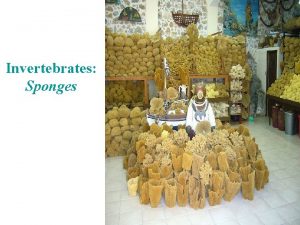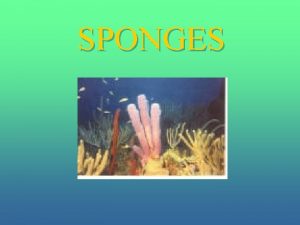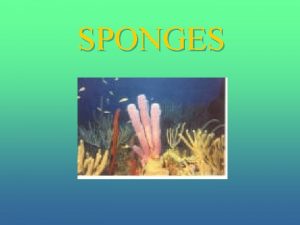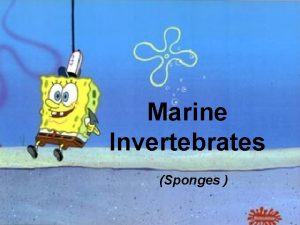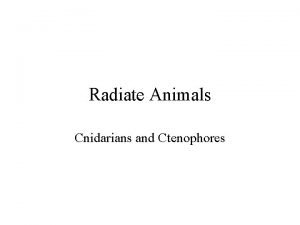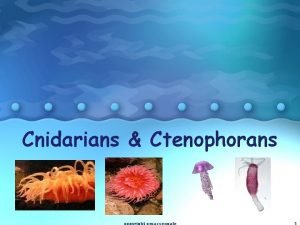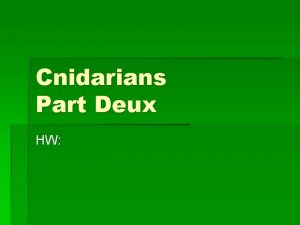Ch 32 33 Sponges Cnidarians Ctenophores What is























- Slides: 23

Ch. 32 - 33 – Sponges, Cnidarians, & Ctenophores ® What is an invertebrate? ®An animal without a backbone. ® What are some examples? ® Animals are classified by their shape or symmetry. ® What is symmetry? ®Arrangement of body parts around a central axis.

Types of Symmetry ® 1. Asymmetrical – an organism without a definite shape. ®Ex. Sponge ® 2. Radial symmetry – an organism that can be divided into similar halves by any plane that passes through its longitudinal axis. ®Ex. hydra

® 3. Bilateral symmetry – is an organism that can be divided into similar halves by only one specific plane passing through its longitudinal axis. ®Ex. Humans, spiders, fish

Parts of an organisms’ surface ® 1. Posterior – lower end of the organism ®Ex. Feet of humans ® 2. Anterior – upper end of the organism. ®Ex. Head of a human ® 3. Dorsal – top surface of an organism. ®Ex. Back on a human ® 4. Ventral – bottom surface. ®Ex. Belly of a human

Organisms Development ®Organism develop from a zygote ®Then into an embryo ®Next is a blastula – a hollow ball of cells ®Final the blastula caves in and forms a depression called a blastopore. Once the blastula forms a blastopore it is now called a gastrula.

3 Germ Layers ® 1. Ectoderm – outside layer of cells ®Ex. Skin ® 2. Endoderm inside layer of cells ®Ex. Organs ® 3. Mesoderm – middle layer of cells ®Ex. Muscles

Porifera (phylum) ®Sponges ®No gastrula stage ®No true organs ®Sessile – don’t move ®Very colorful

Features of a sponge ®Osculum – top opening of a sponge ®A sponge is hollow in the middle ®The sponge’s hollow cavity is lined with collar cells, which have flagella. ®The collar cells are used to filter out food. Water and food enter the sponge through its pores then pass back out its osculum. Sponges are filter feeders.

®Amebocytes transport the food from the collar cells to the rest of sponge. ®Sponges have the ability to reproduce sexually or asexually; sponges carry both egg and sperm cells. ®Sponges reproduce asexually by producing buds called gemmules.

®Sponges have the ability to regrow missing parts. What is this called? ®Regeneration ®Most sponges have both sperm and egg cells, some have separate sexes. ®Hermaphrodite is an organism with both egg and sperm cells. ®Video Clip


Cnidaria (phylum) ®Example: jellyfish, hydra, coral ®Have endoderm & ectoderm layers ®All live in water (mainly marine) ®Have stinging cells called nematocyst ®Have a hollow gut ®Have tentacles

2 body shapes of Cnidarians ® 1. Polyp ®Sessile and vase-like shape ® 2. Medusa ®Swimming and bell shape ®All cnidarians use their tentacles to capture and paralyze their prey with a coiled stinger called a nematocyst.

® 3 Classes of Cnidarians ® 1. Hydrozoa – Hydra ®Both polyps and medusa shapes ® 2. Scyphozoa – jellyfish ®Mostly medusa ® 3. Anthozoa – corals ®Only as polyps

Hydrozoa (class) ® Hydra use their nematocyst to capture prey and engulf the whole prey into their gastro vascular cavity. They only have one opening (mouth and anus). ® Asexual reproduction of small buds occurs during warm weather. ® Sexual reproduction occurs mainly in the fall. ® Hydra are hermaphrodites. ® Video Clip

Scyphozoa (class) ®Mostly medusa ®Jellyfish have poisonous tentacles with nematocyst, also. ®Several humans been seriously injured and even killed from jellyfish off the coast of Australia. ®Video Clip



Anthozoa (class) ®Only polyp ®Sea anemones are polyps along rocks. ®Clown fish swim around in their tentacles. The clown fish is protected from the tentacles by a chemical in their skin that doesn’t allow the nematocyst to fire. ®Video Clip



3 main body cavities of organisms ® 1. Acoelomate – without a body cavity. ®Ex. Hydra, planaria ® 2. Pseudocoelomate – false body cavity. No true digestive system. The gut is suspended in fluid, not muscle. ®Ex. Roundworm ® 3. Coelomate – a true body cavity. ®Ex. Earthworm, insects, humans, ect.

Rotifera (phylum) ®Rotifers ®Free-swimming ®Marine and freshwater ®Cilia along its mouth, which is used to sweep food into its mouth. ®Looks like a spinning wheel as it moves. ®Video Clip
 Chapter 24 body plans of animals with bilateral symmetry
Chapter 24 body plans of animals with bilateral symmetry Sponges
Sponges Sponges cnidarians and worms
Sponges cnidarians and worms Cnidarians and sponges
Cnidarians and sponges Sponges cnidarians and worms
Sponges cnidarians and worms Section 33-2 review cnidaria and ctenophora answer key
Section 33-2 review cnidaria and ctenophora answer key Chapter 26 sponges and cnidarians answer key
Chapter 26 sponges and cnidarians answer key How do you pronounce cnidarians
How do you pronounce cnidarians Are cnidarians autotrophs
Are cnidarians autotrophs Symmetry
Symmetry What do these additions allow cnidarians to do?
What do these additions allow cnidarians to do? Porifera and cnidaria
Porifera and cnidaria What are the two body forms of cnidarians?
What are the two body forms of cnidarians? Cnidarians characteristics
Cnidarians characteristics Cnidaria
Cnidaria Cnidoblast
Cnidoblast Body plan of cnidaria
Body plan of cnidaria 2 body forms of cnidarians
2 body forms of cnidarians Phylum cnidaria and ctenophora
Phylum cnidaria and ctenophora Phylum
Phylum Sponge types
Sponge types Diagram of sponges
Diagram of sponges Sponges invertebrates
Sponges invertebrates Economic importance of sponge
Economic importance of sponge
